大数的读法和写法
- 格式:ppt
- 大小:3.06 MB
- 文档页数:90
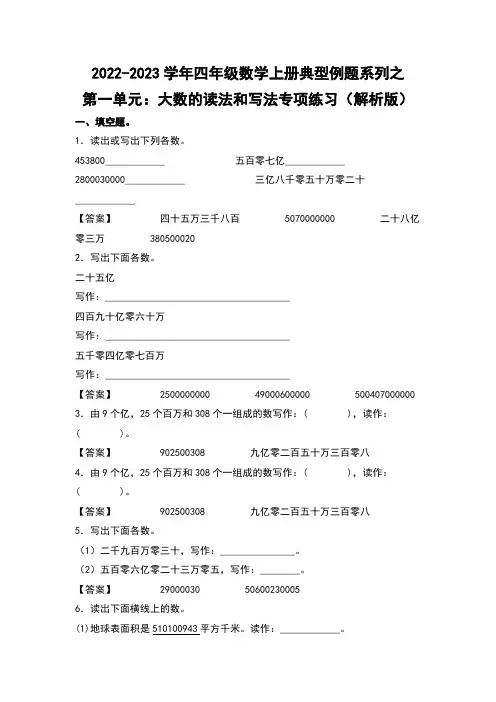
2022-2023学年四年级数学上册典型例题系列之第一单元:大数的读法和写法专项练习(解析版)一、填空题。
1.读出或写出下列各数。
453800____________ 五百零七亿____________2800030000____________ 三亿八千零五十万零二十____________【答案】四十五万三千八百 5070000000 二十八亿零三万 3805000202.写出下面各数。
二十五亿写作:_____________________________________四百九十亿零六十万写作:_____________________________________五千零四亿零七百万写作:_____________________________________【答案】 2500000000 49000600000 500407000000 3.由9个亿,25个百万和308个一组成的数写作:( ),读作:( )。
【答案】 902500308 九亿零二百五十万三百零八4.由9个亿,25个百万和308个一组成的数写作:( ),读作:( )。
【答案】 902500308 九亿零二百五十万三百零八5.写出下面各数。
(1)二千九百万零三十,写作:_______________。
(2)五百零六亿零二十三万零五,写作:________。
【答案】 29000030 506002300056.读出下面横线上的数。
(1)地球表面积是510100943平方千米。
读作:____________。
(2)原子弹爆炸可产生的温度为100000000℃。
读作:____________。
【答案】(1)五亿一千零一十万零九百四十三;(2)一亿二、解答题。
7.写出下面各数。
二十三万零一百八十四十万二千三百四十五三百零二万六千二千零四十万零七百【答案】230184;102345;3026000;204007008.读出人口普查数据中的大数:与2010年第六次全国人口普查相比,31个省份中,有25个省份人口增加。
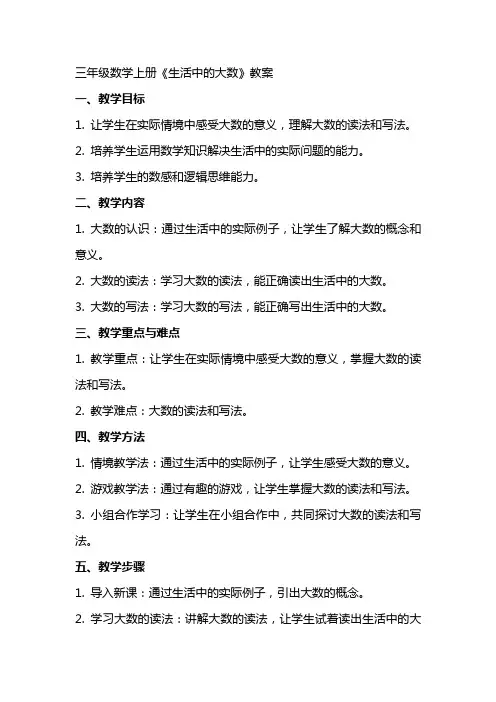
三年级数学上册《生活中的大数》教案一、教学目标1. 让学生在实际情境中感受大数的意义,理解大数的读法和写法。
2. 培养学生运用数学知识解决生活中的实际问题的能力。
3. 培养学生的数感和逻辑思维能力。
二、教学内容1. 大数的认识:通过生活中的实际例子,让学生了解大数的概念和意义。
2. 大数的读法:学习大数的读法,能正确读出生活中的大数。
3. 大数的写法:学习大数的写法,能正确写出生活中的大数。
三、教学重点与难点1. 教学重点:让学生在实际情境中感受大数的意义,掌握大数的读法和写法。
2. 教学难点:大数的读法和写法。
四、教学方法1. 情境教学法:通过生活中的实际例子,让学生感受大数的意义。
2. 游戏教学法:通过有趣的游戏,让学生掌握大数的读法和写法。
3. 小组合作学习:让学生在小组合作中,共同探讨大数的读法和写法。
五、教学步骤1. 导入新课:通过生活中的实际例子,引出大数的概念。
2. 学习大数的读法:讲解大数的读法,让学生试着读出生活中的大3. 学习大数的写法:讲解大数的写法,让学生试着写出生活中的大数。
4. 巩固练习:设计一些练习题,让学生运用所学知识解决实际问题。
5. 总结反思:让学生谈谈自己在学习过程中的收获和感受。
六、教学评价1. 通过课堂表现、练习题和小组合作的情况,评价学生在学习中对大数的认识、读法和写法的掌握程度。
2. 关注学生在解决实际问题中的数感和逻辑思维能力的运用。
七、教学拓展1. 让学生收集生活中的大数,进行交流分享,进一步感受大数在实际生活中的应用。
2. 结合数学日记,让学生记录生活中遇到的大数及解决方法,提高学生的应用能力。
八、教学资源1. PPT课件:展示生活中的大数实例,方便学生直观理解。
2. 练习题:设计不同难度的练习题,巩固学生对大数的认识。
3. 小组讨论工具:如白板、彩笔等,方便小组合作学习。
九、教学建议1. 在教学中,注重引导学生从实际情境中发现大数,激发学生的学习兴趣。

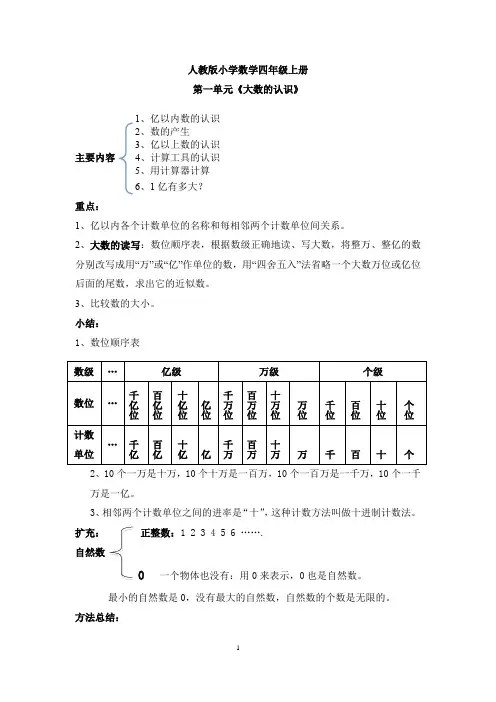
人教版小学数学四年级上册第一单元《大数的认识》1、亿以内数的认识2、数的产生3、亿以上数的认识主要内容4、计算工具的认识5、用计算器计算6、1亿有多大?重点:1、亿以内各个计数单位的名称和每相邻两个计数单位间关系。
2、大数的读写:数位顺序表,根据数级正确地读、写大数,将整万、整亿的数分别改写成用“万”或“亿”作单位的数,用“四舍五入”法省略一个大数万位或亿位后面的尾数,求出它的近似数。
3、比较数的大小。
小结:1、数位顺序表2、10个一万是十万,10个十万是一百万,10个一百万是一千万,10个一千万是一亿。
3、相邻两个计数单位之间的进率是“十”,这种计数方法叫做十进制计数法。
扩充: 正整数:1 2 3 4 5 6 …….自然数0一个物体也没有:用0来表示,0也是自然数。
最小的自然数是0,没有最大的自然数,自然数的个数是无限的。
方法总结:一、大数的读法:①、从高位数读起,一级一级往下读。
②、亿级和万级的数要按照个级的数的读法来读,再在后面加一个万字。
③、每级末尾不管有几个零都不读,其他数位有一个“零”或连续几个“零”,都只读一个“零”。
二、大数的写法:①、从高级写起,一级一级往下写。
②、当哪一位上一个计数单位也没有,就在哪一位上写0 。
三、比较数的大小:①、位数多的时候,这个数就比较大。
②、当这两个数位数相同的时候,我们就应该从左起的第一位比起,也就是从最高位开始比,哪个数最高位上的数大,这个数就大。
③、如果碰到最高位上的数相同的时候,就再比下一位,以此类推,直到我们比较出相同的数位上的那个数,哪个数大的时候,我们就可以断定这个数比较大。
四、改写成“万”、“亿”做单位的数:有时候,为了读写方便,我们把整万的数改写成以“万”做单位的数,省略最后四个零;整亿的数改写成有“亿”做单位的数,省略最后八个零。
五、求近似数:求近似数的方法叫“四舍五入法”,是“舍”还是“入”,就看要省略的位数的下一位是小于5还是等于或大于5。
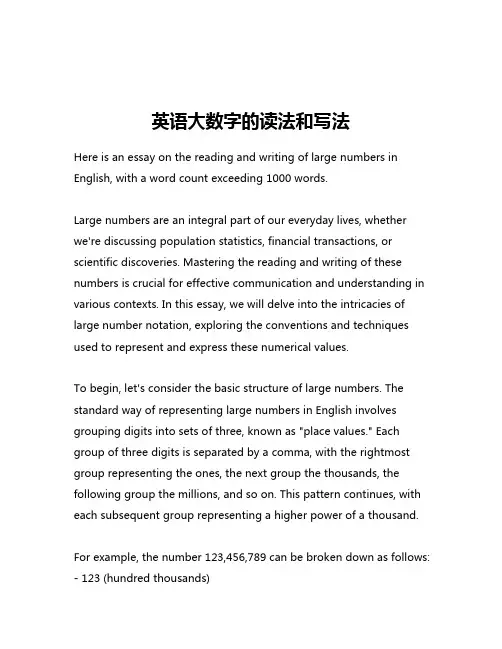
英语大数字的读法和写法Here is an essay on the reading and writing of large numbers in English, with a word count exceeding 1000 words.Large numbers are an integral part of our everyday lives, whetherwe're discussing population statistics, financial transactions, or scientific discoveries. Mastering the reading and writing of these numbers is crucial for effective communication and understanding in various contexts. In this essay, we will delve into the intricacies of large number notation, exploring the conventions and techniques used to represent and express these numerical values.To begin, let's consider the basic structure of large numbers. The standard way of representing large numbers in English involves grouping digits into sets of three, known as "place values." Each group of three digits is separated by a comma, with the rightmost group representing the ones, the next group the thousands, the following group the millions, and so on. This pattern continues, with each subsequent group representing a higher power of a thousand.For example, the number 123,456,789 can be broken down as follows: - 123 (hundred thousands)- 456 (thousands)- 789 (ones)This systematic approach to large number representation allows for easy reading and understanding, as the commas act as visual cues to help the reader quickly identify the different place values.When it comes to reading and writing large numbers, there are specific conventions that must be observed. For numbers less than a thousand, the reading and writing process is relatively straightforward. We simply read the digits as they are written, such as "two hundred and forty-five" or "789."However, as the numbers become larger, the reading and writing process becomes more complex. For numbers in the thousands, millions, and beyond, we need to incorporate specific terminology to accurately convey the magnitude of the value.For numbers in the thousands, we use the following terminology:- Thousand(s)Example: 5,678 is read as "five thousand, six hundred and seventy-eight."For numbers in the millions, we use the following terminology:- Million(s)Example: 12,345,678 is read as "twelve million, three hundred and forty-five thousand, six hundred and seventy-eight."The pattern continues for higher place values, with the following terms:- Billion(s)- Trillion(s)- Quadrillion(s)- Quintillion(s)- Sextillion(s)- Septillion(s)- Octillion(s)- Nonillion(s)- Decillion(s)It's important to note that the use of these terms can vary slightly in different regions or contexts. For instance, in some countries, the term "milliard" is used instead of "billion" to represent a thousand millions.When writing large numbers, it's crucial to maintain consistency in the use of commas and the appropriate terminology. For example, the number 12,345,678,901 would be written as "twelve billion, three hundred and forty-five million, six hundred and seventy-eight thousand, nine hundred and one."In addition to the standard numerical representation, large numbers can also be expressed using words. This can be particularly useful in formal or legal contexts, where precise communication is essential. To write large numbers in words, we follow a similar pattern to the spoken form, but with some additional considerations.For numbers less than a hundred, we use the standard word form (e.g., "forty-two," "seventy-five"). For numbers in the hundreds, we use the word "hundred" (e.g., "two hundred and sixty-three"). For numbers in the thousands, we use the word "thousand" (e.g., "five thousand, eight hundred and twelve"). The pattern continues for higher place values, with the use of "million," "billion," and so on.It's important to note that the word form of large numbers can be more prone to ambiguity or misinterpretation, especially when dealing with very large values. In such cases, the numerical representation is often preferred to ensure clarity and precision.In conclusion, the reading and writing of large numbers in English is a crucial skill that enables effective communication and understanding in various contexts. By mastering the conventions of place value, comma usage, and appropriate terminology, we can accurately represent and convey numerical values of any magnitude. Whether you're working with population statistics, financial data, orscientific discoveries, the ability to effectively handle large numbers is an invaluable asset.。

生活中的大数第拨一拨CATALOGUE目录•生活中的大数•大数的读写•大数的比较和排序•大数的计算•大数的应用•大数的总结和回顾CATALOGUE生活中的大数解释例子2人口统计:在人口统计中,我们经常遇到以亿为单位的数字,比如中国的人口约为14亿人。
例子1房价:在购买房产时,我们通常会遇到以万元为单位的房价,比如300万元、500万元等。
例子3股票市场:在股票市场中,我们经常看到股票价格以元、万元为单位进行波动,比如某只股票价格为3000元/股。
重要性1重要性2重要性3生活中的大数的重要性CATALOGUE 大数的读写整数部分的读法小数部分的读法科学计数法030201整数部分的写法小数部分的写法科学计数法位数数位大数的位数和数位CATALOGUE大数的比较和排序位数不等的比较当两个大数的位数不相同时,位数多的数较大。
例如:999和1000,1000比999大。
位数相同的比较当两个大数的位数相同时,先比较最高位上的数字,数字大的那个数就大。
如果最高位上的数字相同,则依次比较次高位、次次高位……直到比较出大小为止。
例如:4567和4568,4568比4567大。
将大数按从小到大的顺序排列。
例如:1234、5432、9876,则排列为1234、5432、9876。
从小到大排序从大到小排序大数的取舍根据实际需要,将大数截取到所需位数。
例如:将3.14159取到小数点后两位,得到3.14。
大数的四舍五入根据实际需要,将大数四舍五入到所需位数。
例如:将3.14159四舍五入到小数点后两位,得到3.14。
大数的取舍和四舍五入CATALOGUE 大数的计算详细描述总结词详细描述乘方和开方是大数计算中常用的运算,需要掌握正确的计算方法和技巧,才能得到准确的结果。
详细描述在进行大数乘方和开方计算时,需要将数字拆分成多个位数,并使用指数表示幂次。
需要注意乘方的指数和底数的取值范围,以及开方的根号内是否为负数的情况。
同时,还需要掌握一些简便算法,如平方差公式、完全平方公式等,以提高计算速度和准确性。
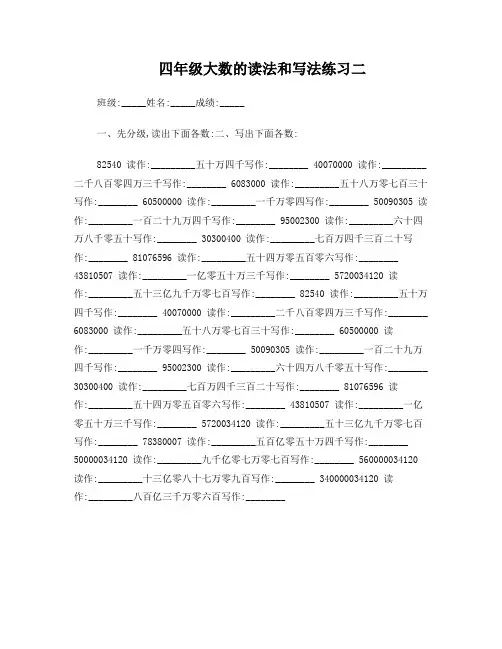
四年级大数的读法和写法练习二班级:_____姓名:_____成绩:_____一、先分级,读出下面各数:二、写出下面各数:82540 读作:_________五十万四千写作:________ 40070000 读作:_________二千八百零四万三千写作:________ 6083000 读作:_________五十八万零七百三十写作:________ 60500000 读作:_________一千万零四写作:________ 50090305 读作:_________一百二十九万四千写作:________ 95002300 读作:_________六十四万八千零五十写作:________ 30300400 读作:_________七百万四千三百二十写作:________ 81076596 读作:_________五十四万零五百零六写作:________ 43810507 读作:_________一亿零五十万三千写作:________ 5720034120 读作:_________五十三亿九千万零七百写作:________ 82540 读作:_________五十万四千写作:________ 40070000 读作:_________二千八百零四万三千写作:________ 6083000 读作:_________五十八万零七百三十写作:________ 60500000 读作:_________一千万零四写作:________ 50090305 读作:_________一百二十九万四千写作:________ 95002300 读作:_________六十四万八千零五十写作:________ 30300400 读作:_________七百万四千三百二十写作:________ 81076596 读作:_________五十四万零五百零六写作:________ 43810507 读作:_________一亿零五十万三千写作:________ 5720034120 读作:_________五十三亿九千万零七百写作:________ 78380007 读作:_________五百亿零五十万四千写作:________ 50000034120 读作:_________九千亿零七万零七百写作:________ 560000034120 读作:_________十三亿零八十七万零九百写作:________ 340000034120 读作:_________八百亿三千万零六百写作:________。
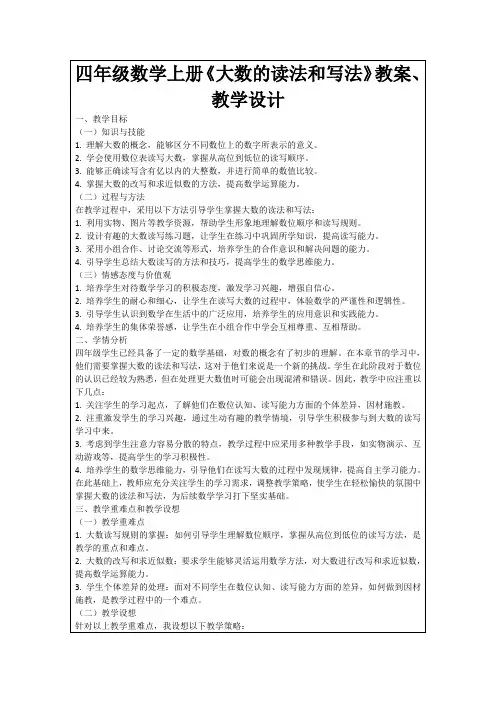
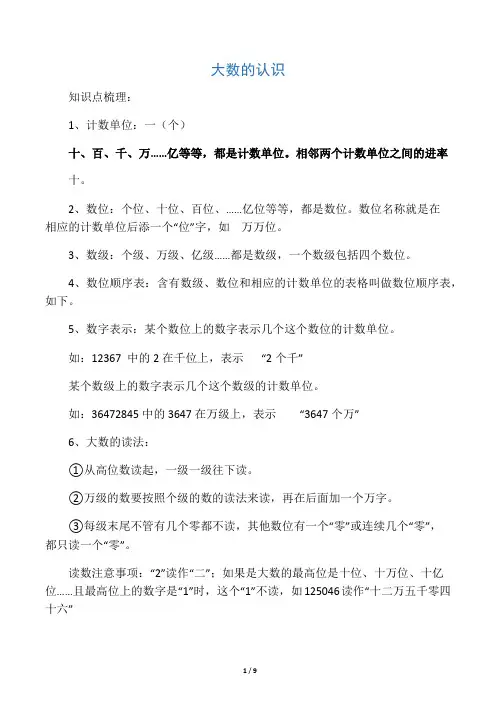
大数的认识知识点梳理:1、计数单位:一(个)十、百、千、万……亿等等,都是计数单位。
相邻两个计数单位之间的进率十。
2、数位:个位、十位、百位、……亿位等等,都是数位。
数位名称就是在相应的计数单位后添一个“位”字,如万万位。
3、数级:个级、万级、亿级……都是数级,一个数级包括四个数位。
4、数位顺序表:含有数级、数位和相应的计数单位的表格叫做数位顺序表,如下。
5、数字表示:某个数位上的数字表示几个这个数位的计数单位。
如:12367 中的2在千位上,表示“2个千”某个数级上的数字表示几个这个数级的计数单位。
如:36472845中的3647在万级上,表示“3647个万”6、大数的读法:①从高位数读起,一级一级往下读。
②万级的数要按照个级的数的读法来读,再在后面加一个万字。
③每级末尾不管有几个零都不读,其他数位有一个“零”或连续几个“零”,都只读一个“零”。
读数注意事项:“2”读作“二”;如果是大数的最高位是十位、十万位、十亿位……且最高位上的数字是“1”时,这个“1”不读,如125046读作“十二万五千零四十六”7、大数的写法:①从高级写起,一级一级往下写。
②当哪一位上一个计数单位也没有,就在哪一位上写0 。
写数注意事项:一定要注意“四位一级”,保证每级有四个数位,不够的要用0补足。
8、读写数检验方法:读数和写数可以互相检验,即读数后再写出来和原数比对,而写数后可以自己读出。
9、写出所组成的数:对照数位顺序表把每个部分的数字分别写入,再用0补足。
如:0、大数的比较:①位数多的这个数就比较大。
②当这两个数位数相同的时候,我们就应该从左起的第一位比起,也就是从最高位开始比,哪个数最高位上的数大,这个数就大。
③如果碰到最高位上的数相同的时候,就再比下一位,以此类推,直到我们比较出相同的数位上的那个数,哪个数大的时候,我们就可以断定这个数比较大。
1、四舍五入法:求“近似数”的一种方法,首先确定需要精确到的数位,将其后面的数作为“尾数”,对尾数最高位上的数字进行取舍。
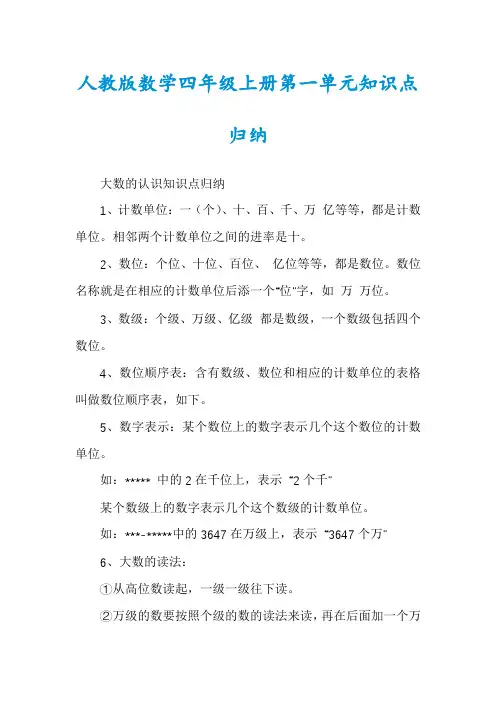
人教版数学四年级上册第一单元知识点归纳大数的认识知识点归纳1、计数单位:一(个)、十、百、千、万亿等等,都是计数单位。
相邻两个计数单位之间的进率是十。
2、数位:个位、十位、百位、亿位等等,都是数位。
数位名称就是在相应的计数单位后添一个“位”字,如万万位。
3、数级:个级、万级、亿级都是数级,一个数级包括四个数位。
4、数位顺序表:含有数级、数位和相应的计数单位的表格叫做数位顺序表,如下。
5、数字表示:某个数位上的数字表示几个这个数位的计数单位。
如:***** 中的2在千位上,表示“2个千”某个数级上的数字表示几个这个数级的计数单位。
如:***-*****中的3647在万级上,表示“3647个万”6、大数的读法:①从高位数读起,一级一级往下读。
②万级的数要按照个级的数的读法来读,再在后面加一个万字。
③每级末尾不管有几个零都不读,其他数位有一个“零”或连续几个“零”,都只读一个“零”。
读数注意事项:“2”读作“二”;如果是大数的最高位是十位、十万位、十亿位且最高位上的数字是“1”时,这个“1”不读,如*****读作“十二万五千零四十六”7、大数的写法:①从高级写起,一级一级往下写。
②当哪一位上一个计数单位也没有,就在哪一位上写0 。
知识点归纳写数注意事项:一定要注意“四位一级”,保证每级有四个数位,不够的要用0补足。
8、读写数检验方法:读数和写数可以互相检验,即读数后再写出来和原数比对,而写数后可以自己读出。
9、写出所组成的数:对照数位顺序表把每个部分的数字分别写入,再用0补足。
如:10、大数的比较:①位数多的这个数就比较大。
②当这两个数位数相同的时候,我们就应该从左起的第一位比起,也就是从最高位开始比,哪个数最高位上的数大,这个数就大。
③如果碰到最高位上的数相同的时候,就再比下一位,以此类推,直到我们比较出相同的数位上的那个数,哪个数大的时候,我们就可以断定这个数比较大。
11、四舍五入法:求“近似数”的一种方法,首先确定需要精确到的数位,将其后面的数作为“尾数”,对尾数最高位上的数字进行取舍。
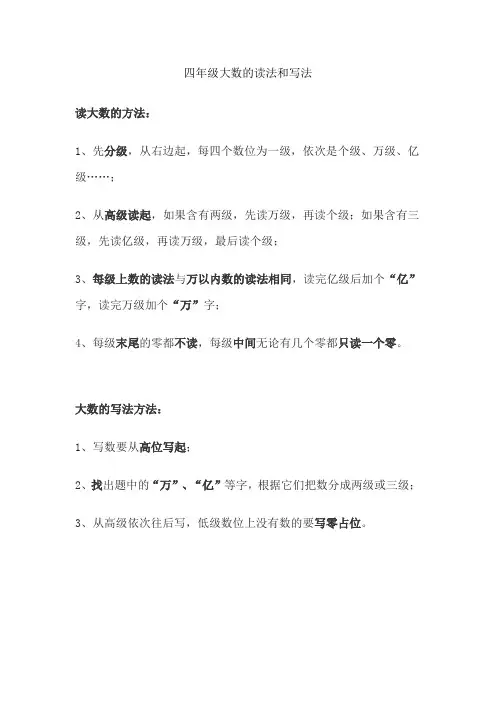
四年级大数的读法和写法
读大数的方法:
1、先分级,从右边起,每四个数位为一级,依次是个级、万级、亿级……;
2、从高级读起,如果含有两级,先读万级,再读个级;如果含有三级,先读亿级,再读万级,最后读个级;
3、每级上数的读法与万以内数的读法相同,读完亿级后加个“亿”字,读完万级加个“万”字;
4、每级末尾的零都不读,每级中间无论有几个零都只读一个零。
大数的写法方法:
1、写数要从高位写起;
2、找出题中的“万”、“亿”等字,根据它们把数分成两级或三级;
3、从高级依次往后写,低级数位上没有数的要写零占位。
四年级大数的读法和写法练习二一、先分级,读出下面各数:二、写出下面各数:40080007读作:_________三亿五千万写作:________12000056000读作:_________四亿九千六百万七千五百写作:________1503800读作:_________七千零五十二万四千写作:________9000900090读作:_________六百三十万八千九百六十写作:________8543718读作:_________四十三亿零九十六万写作:________30080070读作:_________六亿八千四百三十万九千写作:________909090090读作:_________九十万二千零六十写作:________6100000000读作:_________三百零七万八千四百写作:________501305080000读作:_________三千零六十亿零二十万写作:________26705000000读作:_________二十六万零四百写作:________786000000读作:_________八十五亿零一千写作:________306000200000读作:_________七亿八千六百万写作:_______260800070读作:_________五十亿五千万五千写作:________82540读作:_________五十万四千写作:________40070000读作:_________二千八百零四万三千写作:________6083000读作:_________五十八万零七百三十写作:________60500000读作:_________一千万零四写作:________50090305读作:_________一百二十九万四千写作:________95002300读作:_________六十四万八千零五十写作:________30300400读作:_________七百万四千三百二十写作:________81076596读作:_________五十四万零五百零六写作:________43810507读作:_________一亿零五十万三千写作:________5720034120读作:_________五十三亿九千万零七百写作:________34560000读作:_________九十九万零三百写作:________。
英文大数字的读法和写法英文大数字的读法和写法1. 1000 - One thousand2. 10,000 - Ten thousand3. 100,000 - One hundred thousand4. 1,000,000 - One million5. 10,000,000 - Ten million6. 100,000,000 - One hundred million7. 1,000,000,000 - One billion8. 10,000,000,000 - Ten billion9. 100,000,000,000 - One hundred billion10. 1,000,000,000,000 - One trillionTo get a better understanding of how these numbers are written in English, we can break them down by place value. For example:- 1,264 is written as "one thousand, two hundred sixty-four."- 58,943 is written as "fifty-eight thousand, nine hundred forty-three."- 2,354,789 is written as "two million, three hundred fifty-four thousand, seven hundred eighty-nine."- 325,000,000 is written as "three hundred twenty-five million."Large numbers in English often use commas to separate groups of three digits, starting with the ones place. It's important to note that in American English, the word "billion" means 1,000,000,000, while in British English itused to mean 1,000,000,000,000 but has been standardized to mean the American meaning.Understanding how to read and write large numbers in English is important for communicating about finances, populations, and other numerical data. Practice with these examples and use them in context to become more comfortable with these numbers.。
大数的读法和写法练习(一)姓名_________成绩____________【熟读概念】1、整数和小数的数位顺序表2、Array大数读法:从高位起一①相同点:都是改变原来数的计数单位。
换成用“亿”或“万”作单位。
②不同点:“改写”只改变数的单位,不改变数的大小,用“=”表示。
“省略”是用四舍五入法,既改变了数的单位,又改变数的大小,用“≈表示。
7、自然数:表示物体个数的1、2、3、4、5、6、7、8、9、10……都是自然数。
一个物体也没有,用0表示。
0也是自然数。
最小的自然数是0,自然数的单位是1,自然数的个数是无限的。
没有最大的自然数。
8、十进制计数法:每相邻的两个计数单位之间的进率都是十,这种计数方法叫做十进制计数法。
(相隔一个计数单位是100进率,相隔两个计数单位是……)9、12345、67、.8、由39();10、在5072348中,5在()位,它的计数单位是(),表示().11、五个连续自然数的和是115,这五个自然数从小到大排列是().12、三千亿四千万五千,写作();它是()位数.13、把两个数合并成一个数的运算叫做();已知两个加数的和与其中的一个加数,求另一个加数的运算叫做(),它是()的逆运算.14、求几个相同加数的和的简便运算叫做().15、已知两个因数的积与其中的一个因数,求另一个因数的运算叫做(),它是()的逆运算.16、计算除法时,每次除得的余数都要比()小.17、计算386÷48时,我们用()法把48看成()试商.18、在除法里,被除数和除数同时扩大或同时缩小相同的倍数,()不变.这叫做().在这个数中,()位和()位上的0不读..被减数、减数、差三者的和是102,被减数是()一个因数不变,另一个因数扩大若干倍,积()的倍数.在除法里,被除数和除数()扩大或缩小()的倍数,商不变.在下面括号里填最大的数.139×()<420241×()<2300162×()<660254×()<1400一个数的百万位和万位都是5,千位上是6,其他各个数位上都是0(5分)①这个数写作______,读作______.②这个数的最高位是______位,它是______位数.③省略万后面的尾数得到的近似数是______.1.五十三亿四千九百万零五十写作(),省略亿位后面的尾数,约等于()亿。
《大数的读法和写法》教学案2 教学目标:1、在收集数据的过程中,掌握大数的写法。
2、掌握求近似数的方法以及数的改写的方法。
教学内容:(一)千亿以内数的读法1. 认识个级、万级、亿级。
数位顺序表2000年我国进行了第五次人口普查:祖国大陆约有1265830000人。
北京约有13820000人。
香港约有6780000人。
澳门约有440000人。
天津约有10010000人。
全国总人口约为1295330000人。
再在后面加上“亿”字或“万”字。
3. 练习(1)读出下面各数364837 165491273 368000 5600000000(2)读出下面各数。
(小组内同学试着读一读。
)36500,2305000,1040603,170092006思考:一个数里的零怎么读?每级末尾的0都不读,其他数位有一个0或连续有几个0,都只读一个“零”。
(3)读一读。
据2000年人口统计:加拿大约30750000人。
30750000读作:三千零七十五万沙特阿拉伯约21660660人。
21660660读作:两千一百六十六万零六百六十英国约580830800人。
580830800读作:五亿八千零八十三万零八百巴西约169800000人。
169800000读作:一亿六千九百八十万(二)千亿以内数的写法1、写数的方法亚洲的面积是二千七百五十八万平方千米。
欧洲的面积是四百九十三万七千平方千米。
非洲的面积是三千零三十三万八千平方千米。
北美洲的面积是二千一百五十一万五千平方千米。
世界总面积是一亿四千九百四十六万一千平方千米。
方法:先分级,然后按级写数。
强调:写数过程中,不要丢零、少零。
如:。
英文大数字的读法和写法一、数字的读法数字和字母相同,属于语言交际的范畴,其特点是可以用语言读出来。
英文数字的读法与中文数字的读法有很大的区别,因此我们需要认真学习和掌握。
1. 单个数字读法(1) 0:zero / nought(2) 1:one(3) 2:two(4) 3:three(5) 4:four(6) 5:five(7) 6:six(8) 7:seven(9) 8:eight(10) 9:nine2. 十位数字读法(1) 10:ten(2) 20:twenty(3) 30:thirty(4) 40:forty(5) 50:fifty(6) 60:sixty(7) 70:seventy(8) 80:eighty(9) 90:ninety3. 11~19的数字读法11:eleven 12:twelve 13:thirteen 14:fourteen 15:fifteen 16:sixteen 17:seventeen 18:eighteen 19:nineteen4. 100~900的数字读法(1) 100:one hundred(2) 200:two hundred(3) 300:three hundred(4) 400:four hundred(5) 500:five hundred(6) 600:six hundred(7) 700:seven hundred(8) 800:eight hundred(9) 900:nine hundred 5. 1000以上数字的读法(1) 1000:one thousand(2) 10000:ten thousand(3) 1000000:one million(4) 1000000000:one billion二、数字的写法英文数字的写法也是我们需要认真学习的,因为不同于中文,英文数字需要我们用它正确的写法来表达数字的大小。
1、1~9的数字写法(1) 1:one(2) 2:two(3) 3:three(4) 4:four(5) 5:five(6) 6:six(7) 7:seven(8) 8:eight(9) 9:nine2、10~19的数字写法(1) 10:ten(2) 11:eleven(3) 12:twelve(4) 13:thirteen(5) 14:fourteen(6) 15:fifteen(7) 16:sixteen(8) 17:seventeen(9) 18:eighteen(10) 19:nineteen 3、20~90的数字写法(1) 20:twenty(2) 30:thirty(3) 40:forty(4) 50:fifty(5) 60:sixty(6) 70:seventy(7) 80:eighty(8) 90:ninety4、100~900的数字写法(1) 100:one hundred(2) 200:two hundred(3) 300:three hundred(4) 400:four hundred(5) 500:five hundred(6) 600:six hundred(7) 700:seven hundred(8) 800:eight hundred(9) 900:nine hundred5、1000以上的数字写法(1) 1000:one thousand(2) 10000:ten thousand(3) 100000:one hundred thousand(4) 1000000:one million(5) 1000000000:one billion三、从数字到字母的转换方法我们有时候需要把数字转换成字母来表达,这时我们需要使用英文单词,以下是从数字到字母的转换方法:1、0-9对应的字母是:(1) 0:z(2) 1:a(3) 2:b(4) 3:c(5) 4:d(6) 5:e(7) 6:f(8) 7:g(9) 8:h(10) 9:i2、10-15对应的字母是:(1) 10:j(2) 11:k(3) 12:l(4) 13:m(5) 14:n(6) 15:o3、16-21对应的字母是:(1) 16:p(2) 17:q(3) 18:r(4) 19:s(5) 20:t(6) 21:u4、22-25对应的字母是:(1) 22:v(2) 23:w(3) 24:x(4) 25:y以上就是数字的读法和写法,英文数字并不难,只要掌握了规律,就能轻松地理解和使用。